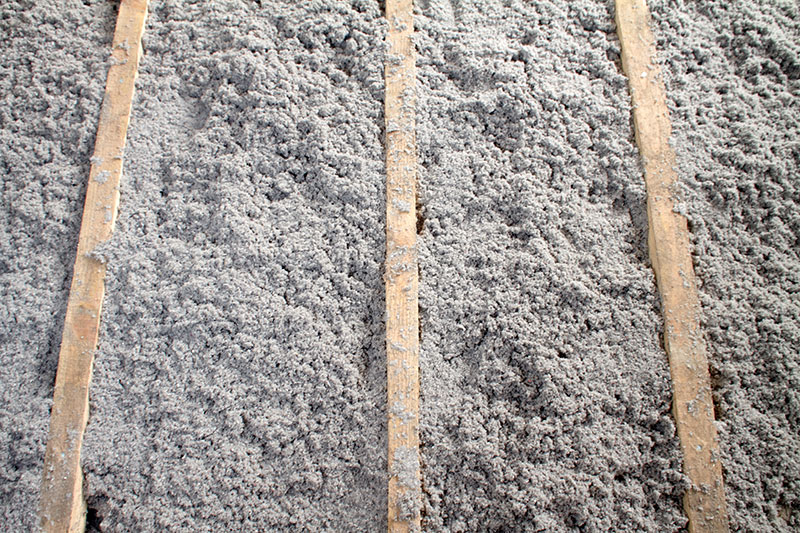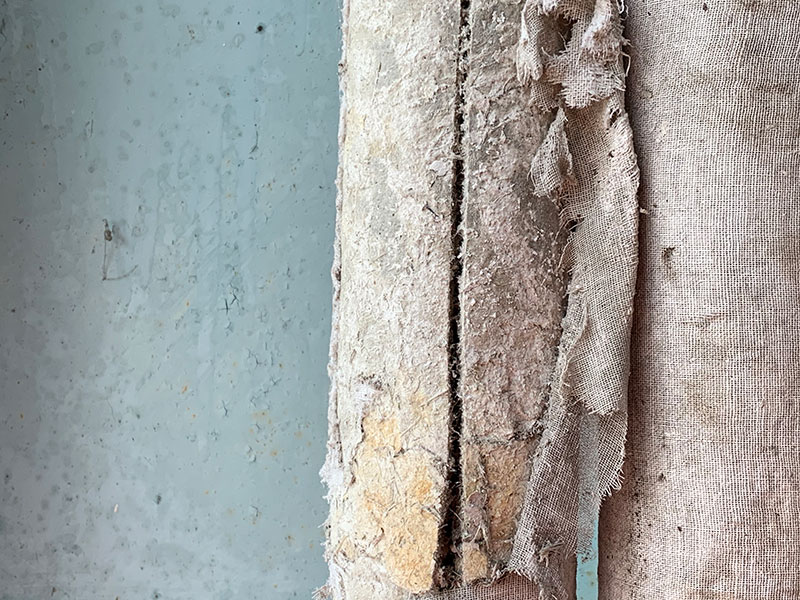How do I manage asbestos in insulation during an energy-efficient retrofit?
As properties age and the climate crisis and energy bills become ever-more urgent topics of political discussion, it also becomes all the clearer how crucial energy-efficient retrofitting is for older properties.
This is not just a concern for property owners themselves, as it is believed that around 27 million houses will need to be retrofitted if the UK Government is to meet its target of all the country’s emissions reaching net zero by 2050. This has spurred on significant action in recent years, including the award of £1.8 billion in 2023 to upgrade social homes and public buildings.
Retrofitting – the term itself referring to the practice of carrying out upgrades to boost a property’s energy efficiency – can take a variety of forms. Replacing a property’s windows, installing more efficient heating, ventilation, and air conditioning (HVAC) systems, and putting in place new insulation, are all examples of retrofitting tasks that can help make a building cheaper to run.
In this article, we will focus particularly on insulation, and the challenge of managing asbestos in insulation. This will include providing practical advice on how you can safely manage asbestos in your property during an energy-efficient retrofit.

Why is asbestos a concern in insulation during retrofits?
All types of asbestos are now banned in the UK, in recognition of the severe dangers they can present to health. For the bulk of the 20th century, however, asbestos was widely used in the UK, including in insulation products such as asbestos insulating board (AIB), loose fill insulation, and lagging.
This naturally occurring mineral was incorporated into insulation products largely due to its heat and fire resistance; it was frequently used to retain heat on pipes or to protect materials from fire. Given that asbestos is formed under volcanic levels of heat, it can withstand temperatures higher than many other modern building products are able to handle.
Unfortunately, however, it was realised over the years that inhalation or ingestion of asbestos fibres could bring about a greatly increased risk of the exposed individual going on to develop an asbestos-related disease. Asbestos-related health conditions such as mesothelioma, asbestos-related lung cancer, and asbestosis can be hugely life-limiting or fatal.
Retrofitting projects such as installing or replacing roof, wall, and floor insulation have the potential to cause significant disruption to the fabric of a building. This could include asbestos-containing materials (ACMs) that may be susceptible to releasing loose fibres.
So, if you are planning a retrofit of your property, you must be vigilant about these risks, and well-prepared to minimise them.
How can I identify asbestos in insulation before starting work?
We have written previously about how you can begin to tell the difference between any asbestos insulation that may be in your property, and any insulation that may be made from other materials. Asbestos was only banned in the UK in all its forms in late 1999, so if your property was constructed before the year 2000, there is a good chance that asbestos will be present.
It must always be emphasised, however, that you can never depend solely on amateur visual inspection as a means of determining whether your building does or does not contain asbestos. So, if you haven’t done so yet, arranging a professional asbestos survey will enable you to confirm the type(s), location(s), amount, and condition of ACMs that may exist within your building, including in the insulation.
Two main types of asbestos survey exist – management surveys and refurbishment or demolition surveys. The latter is the more thorough of these two types, involving destructive inspection. It will therefore enable you to feel more informed and assured about the true asbestos situation in your property before you have retrofitting work done.
Be sure to consult our previous advice on how to choose a suitable asbestos surveyor.
What should I look for in an asbestos survey report?
Following completion of the survey, you can expect a comprehensive asbestos report to be provided to you. This will outline all the ACMs that the surveyor found on your site, complete with information on their asbestos type, amount and condition, as well as photographs.
The report will also set out recommendations on how you can safely manage these ACMs. There may be a need to have certain asbestos materials encapsulated, repaired, or removed altogether from the property, to help control and drive down the risks that ACMs could pose during retrofitting.
What are the legal requirements for managing asbestos in insulation?
The UK’s current overarching asbestos legislation is the Control of Asbestos Regulations 2012 (CAR 2012). These regulations set out various legal requirements that must be complied with to help ensure ACMs are safely managed. They are generally accepted to apply to properties constructed prior to the year 2000, given that buildings of this age may still contain ACMs.
You can read more about the full range of requirements under CAR 2012 – including easy-to-understand associated guidance – by downloading a free PDF copy of the UK Health and Safety Executive (HSE)’s Managing and working with asbestos publication, under the L143 series code.
Confusion can sometimes arise as to whether homeowners would be responsible for managing asbestos under this law. While CAR 2012 is largely directed at non-domestic premises, it can also apply to domestic properties in certain circumstances. It can apply, for instance, to common areas in blocks of flats, such as foyer and lobby areas, lifts, and stairs.
If you are a homeowner living in your own domestic property that you wish to have retrofitted, and you will not be engaged in any work activity yourself, you won’t be legally responsible for any asbestos risks that contractors face due to work in your property. Instead, it will be their own responsibility to protect themselves and any occupants of the building.
The legal situation is different, however, if you are looking to retrofit a domestic property for which you are the landlord, and you have maintenance responsibilities for the structure and exterior of the building. In this situation, you would be classed as a “dutyholder” under CAR 2012.
You would therefore be expected to satisfy the requirements of that duty, including (but not limited to) creating and keeping up to date an asbestos management plan, and providing information on the location and condition of ACMs to anyone liable to work on or disturb them.
What are the best practices for asbestos removal from insulation?
It isn’t automatically the case that if asbestos is found within insulation at your property, the material will need to be removed. However, depending on such factors as the condition of the material and the risk of it being disturbed (including during any retrofit you have planned), it may be necessary to arrange the substance’s removal.
If so, you should make sure you choose the most reputable asbestos removal company to carry out this specialised and sensitive job.
Certain products – such as pipe lagging or asbestos insulation board – will need to be removed by a contractor that holds a licence from the HSE. Even in the case of materials that can be removed without a licensed contractor being legally required, choosing such a professional will give you peace of mind about the quality of the work they will undertake.
Whichever asbestos removal contractor you do choose, they should follow all the recognised best practices. These should encompass the use of containment, ventilation, and suitable personal protective equipment, as well as proper disposal of asbestos insulation materials.
How can I minimise asbestos exposure risks during the retrofit?
Next, it will be time for the retrofitting process itself. The following are ways in which you can help guard against the risks while work such as the replacement of asbestos insulation is taking place at your property:
- Ensuring that any contractors you engage for the retrofit have undergone asbestos awareness training, to help ensure any ACMs are not accidentally disturbed.
- Considering whether it will be necessary to vacate the building and relocate temporarily, if asbestos materials need to be removed.
- Making sure the highest standards of cleanliness are maintained at the property throughout the retrofitting work.
- Arranging for regular asbestos air monitoring. This can provide reassurance if you know certain ACMs are located close to where the retrofitting work is being carried out, and you are concerned about the scope for accidental disturbance and fibre release.
- Maintaining clear and constant communication with your contractors. This will help ensure you stay informed about the progress of work, and that you are alerted as soon as possible to any potential issues or risks.
- Educating yourself on the legal requirements and best practices for the management of asbestos in a property, using resources such as the HSE website and Oracle Solutions’ comprehensive Learning Centre.
Conclusion: effective management of asbestos in insulation can help ensure the safety of your retrofit
As we addressed at the top of this article, energy-efficient retrofitting is a hugely important priority for all manner of buildings in the UK. As part of this crucial work, however, it is also of critical importance to effectively and safely manage any asbestos that may be present in your building’s insulation. Engaging professional expertise and being well-informed on the relevant regulatory requirements, will greatly help you achieve this.
Our accredited and licensed experts at Oracle Solutions would be pleased to help you deliver that safe and successful retrofitting project! Simply contact us now to request our advice, as well as a free and fast quote for any of our asbestos services.

Written by Brendan Coleman
Brendan Coleman, with decades of experience in the asbestos industry, is a dedicated Quality Manager. Certified as a surveyor and analyst, he is adept in operations and quality management with a keen focus on HSE compliance. His expertise is pivotal in maintaining high safety and efficiency standards. Brendan ensures our UKAS accreditation requirements are consistently met and exceeded, upholding stringent standards in asbestos remediation. His commitment to enhancing quality and customer satisfaction makes him an essential advisor in asbestos management.

